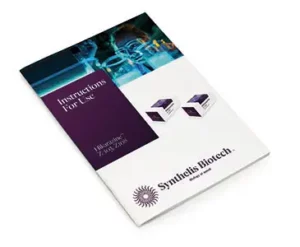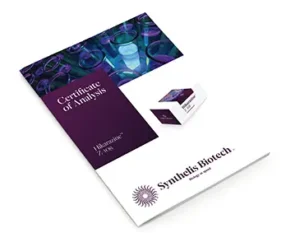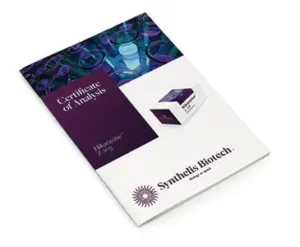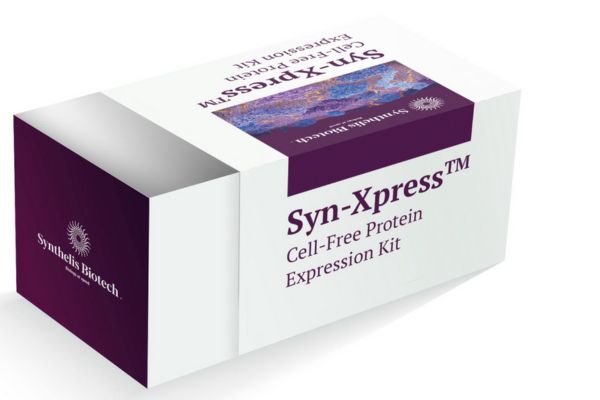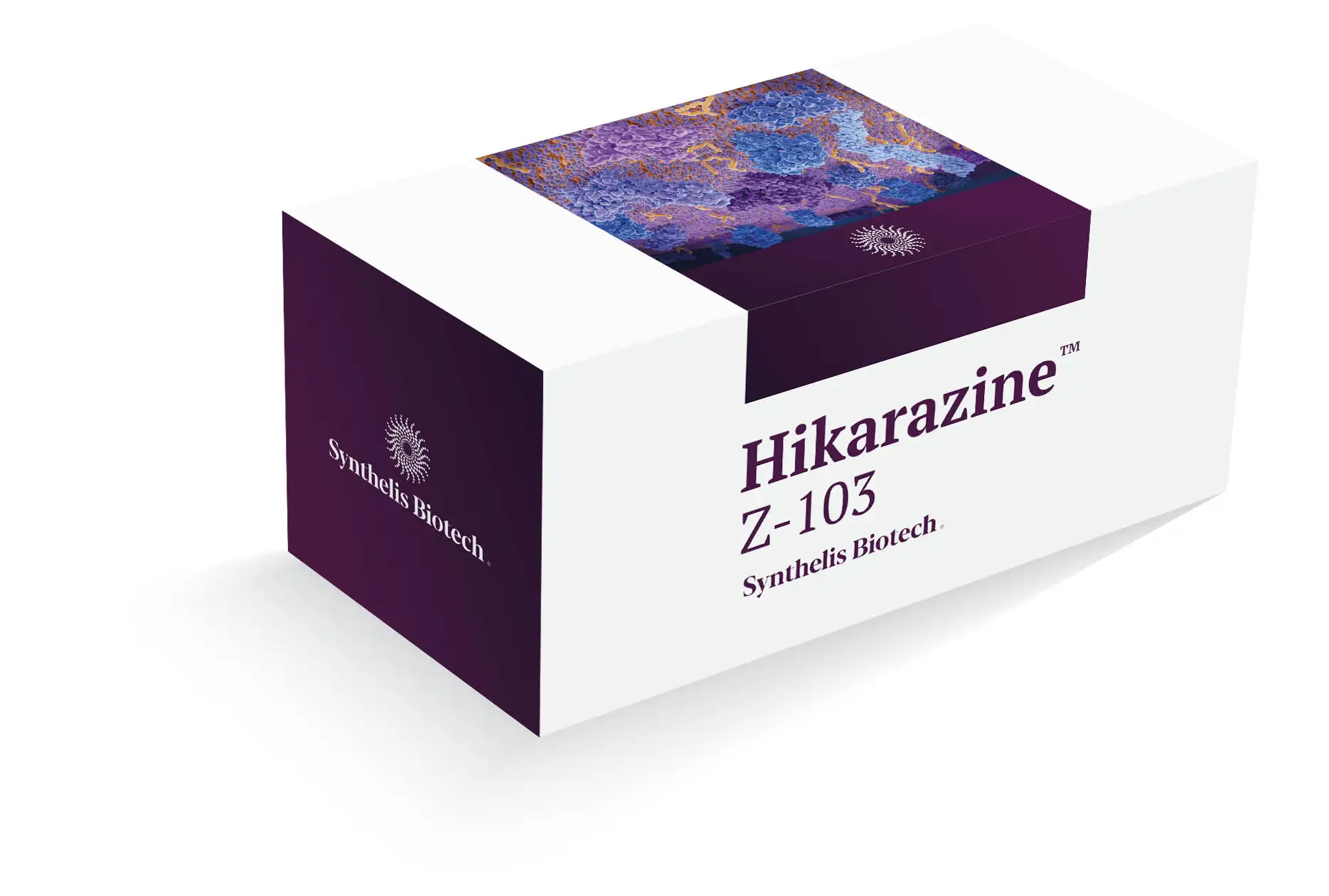Bioluminescence
Pro-substrate
Hikarazine™
Z108

Hikarazine™ Z108 is the brightest substrate in the Hikarazine™ range. With a half-life of 1 hour, Hikarazine™ Z108 is ideal for enhancing sensitivity and for applications where the number of emitted photons is critical.
The use of Hikarazine™ Z108 is reserved for research in biology (RUO) by professionals.
SYN90007-1-01
1 x 1 mg
400 €
SYN90007-5-01
5 x 1 mg
1 600 €
SYN90007-10-01
10 x 1 mg
3 000 €
50, 100, 250 mg
On request
Receive a sample
FAQ
Which luciferases are compatible with Hikarazine™?
Hikarazine™ has been specifically designed for use with luciferase enzymes derived from Oplophorus gracilirostris.
Which Hikarazine™ should I use?
The choice between Hikarazine™ Z108 and Hikarazine™ Z103 depends on your specific assay.
For applications where maximizing light output is crucial, such as bioluminescence microscopy and small animal imaging, Hikarazine™ Z108 is generally the best choice.
For applications requiring longer monitoring times, Hikarazine™ Z103 is recommended. Although it is slightly less bright, some users also report an improved signal-to-noise ratio under specific conditions when using Hikarazine™ Z103.
Which buffer should I use with Hikarazine™?
The choice of buffer is crucial for optimal bioluminescence. PBS is recommended, but other buffers may be used depending on the assay. For instance, adding 0.01% Tween can help with complex matrices, though it may slightly increase background noise. Additionally, varying cation compositions can influence both brightness and bioluminescence half-life. If you need further guidance after testing in your specific assay, please contact our experts.
What factors influence the light emission process and brightness?
The light emission and brightness of Hikarazine™ are influenced by several factors:
. The amount of oxygen available at the luciferase site,
. The buffer composition, which can promote non-radiative relaxation of the substrate’s excited state,
. Temperature, which can affect luciferase activity and the stability of the enzyme-substrate complex, thus altering light intensity,
. Ion concentration, particularly divalent cations, which can influence the efficiency of the bioluminescence reaction,
. The pH of the medium, as inappropriate pH can alter the luciferase enzyme’s activity,
. The presence of cofactors or inhibitors, as some compounds can enhance the reaction’s efficiency, while others may reduce it.
These factors must be optimized to ensure the best performance of the bioluminescent system using Hikarazine™.
What are the optimal storage conditions for maximum stability of the pro-substrate?
To ensure stability for up to two years, store the vials at room temperature, away from heat, light, and humidity.
Why is the pro-substrate powder darkening?
A slight darkening of the surface of the solid may occur over time. However, this does not affect the bioluminescence signal, provided the pro-substrate is used under standard conditions recommended in the IFU.
What are the optimal storage conditions for the stock solution?
The stock solution is acidic, which enhances its stability. When stored at 4°C, it remains stable for 6 months. For extended stability, it can be stored at -20°C, with ongoing tests to determine the exact duration.
What is the peak emission of Hikarazine™?
The peak bioluminescence emission of activated luciferins Hikarazine™ Z103 and Z108 has been measured at 450 ± 3 nm.
What are the recommendations for small animal imaging?
Hikarazine™ substrates contain fluor atoms, enhancing their solubility and bioavailability for small animal imaging. For optimal results, the final blood concentration should be around 13.6 µM, which corresponds to injecting 80 µL of Z103 or Z108 at 1.35 mM per mouse (assuming an average blood volume of 8 mL).
Is Hikarazine™ dependent on ATP?
No, unlike firefly-based bioluminescent systems, marine-based bioluminescent systems, including Hikarazine™, do not require ATP.
Are Hikarazine™ substrates patented?
Yes, Hikarazine™ substrates are patented under EP3615516, US11938199, and JP7366752..
Our customers talk about it

"Hikarazine Z108 has proven to be a superior substitute for standard luciferine substrate in our work with bioluminescence-based reporter bacteriophages. Its stability is a major advantage: after hydrolysis, the luciferin solution remains viable at -20 °C for at least two years, while diluted working stocks remain effective for several weeks, unlike standard luciferine substrate, which has a much shorter shelf life. Additionally, Hikarazine Z108 is significantly more cost-effective, with at least a threefold lower cost per measurement. It also produces little to no background luminescence, ensuring more reliable results without requiring a waiting period before use. Lastly, it offers comparable sensitivity for mid-range bioluminescence levels and enhanced sensitivity for both low and high concentrations, enabling the detection of very small numbers of target cells. These advantages make Hikarazine Z108 our preferred substrate for all bioluminescence-based experiments."
Jasmin BAGGENSTOS

"We are using Hikarazine Z108 to screen the urine/fish pool water containing luciferase-labelled reporter protein for zebrafish model of human kidney disease. Hikarazine shows three times more bioluminescent signals as compared to the standard standard luciferine substrate, which allows to detect lower amount of proteins in the fish pool water."
Zhiyong CHEN

"I am a researcher at the University of Toronto. I developed a novel technique called SIMPL2 which uses split intein coupled with split luciferase to detect protein-protein interactions (PPIs) and their inhibitors. However, several intrinsic issues of conventional luciferase substrate limited the effectiveness of the SIMPL2 assay.
We therefore looked for substitutes and found that Hikarazine compounds outperform other similar substrates in many aspects such as stability, water solubility and brightness. Thus, the utilization of Hikarazine can unleash the full power of SIMPL2 in high throughput studies."
Zhong YAO
"Our lab at the University of Rochester is interested in studying the biogenesis and trafficking of membrane proteins. We have developed a split luciferase approach to detect the surface and total abundance of specific membrane proteins in a high-throughput fashion using a plate reader. The ease of use, brightness, and stability of Hikarazine substrates have made a huge difference in the reliability and sensitivity of our studies. In addition, the cost-effectiveness of Hikarazine has enabled us to truly leverage the high-throughput capabilities of plate readers, allowing for more conditions and comparisons than we could otherwise manage."
David M. MacLean

"We use Hikarazine Z108 as substrate for the enhanced Nano-Lantern (eNL), derived from
Oplophorus gracilirostris. With it, not only have we been able to detect the luminescence
specifically emitted in different tissues of the Caenorhabditis elegans nematode, but also
to couple such light to channelrhodopsins expressed in a nearby cell. We have used
Hikarazine Z108 for imaging from muscles to neurons in sessions that can last up to 2
hours. In the case of functional assays its high stability has allowed us to perform
experiments as long as four hours with no need to refresh the substrate."
Montserrat Porta de la Riva
"In our lab, we focus on studying the interaction network of a small and unique cyanobacterial protein called PipX.
The recent implementation of a complementation bioluminescence system has allowed us
to analyse the in vivo regulation of complex formation in our model organism Synechococcus elongatus.
Nevertheless, to enhance the bioluminescence output while maintaining a cost-effective workflow,
we explored alternative pro-substrates for our luciferase.
Hikarazine Z108 meets these criteria and has enabled us to detect even weak interactions."
Antonio Llop
Other products that may interest you
Our biodesigners
help you
to familiarize yourself
with our system.
If you encounter implementation difficulties, we will be able to accompany you.
Need a quote
or a specific
request?
Even
a protein
needs
to express
its potential.
Cell-Free Systems Applications

